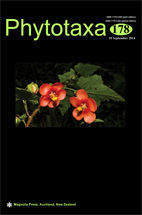Abstract
Relative flower size (RFS) was studied quantitatively in natural populations of Anthurium erskinei (one population) and A. talmonii (two populations) to investigate its potential as a taxonomic descriptor. RFS is defined as the ratio of spadix diameter and transverse floral width in the same region of the spadix. Variation was examined within and between inflorescences, populations and species. Within a single spadix, RFS may vary significantly between basal and upper spadix zones but usually not between basal and middle zones. Within populations, RFS does not differ significantly between spadix zones. Log-transformed RFS values showed significant inter-population differences. In nested ANOVA, between-species variance accounted for >90% of total variance. In A. talmonii between-population within-species variance amounted to >78% of total variance (mean RFS values), and within-spadix-zone within-spadix variance accounted for >31% of total variance (individual values). Bootstrap sampling showed that five pairs of flower and spadix diameter measurements per spadix would provide an adequate estimate of mean RFS for each population. The study suggests that RFS can be a useful quantitative taxonomic floral character for comparing species and populations in the genus Anthurium.

